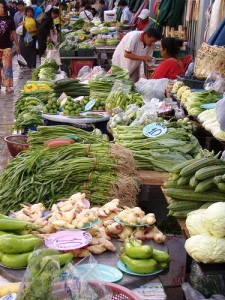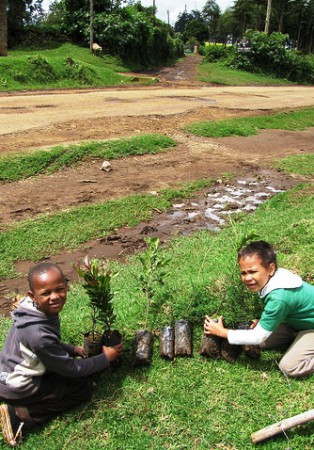- When did the chicken cross the ocean? DNA tells all.
- Hot enough for you? James Hansen makes a statistical case.
- Quinoa mired in controversy. Will any of this affect grand plans for 2013 as International Year of Quinoa?
- Howard G. Buffett busts some myths about smallholder farmers.
Nibbles: Drought, Vegetable talks, Bees, Communications, Resilience, Fungi, Breadfruit tools, Taxonomy, Orphan crops, ICARDA
- The Farnsworth Professor of International Agricultural Policy (Emeritus) and Deputy Director, Center on Food Security and the Environment, Stanford University talks about the drought on his Iowa farm.
- While Ted offers 11 talks on the transformative power of vegetables.
- A new use for urban bees; protecting the lead on church roofs.
- “Agricultural researchers in developing countries are keen to communicate their research …” Scidev.net communicates.
- Growing a high-value crop instead of a staple is not resilience.
- Growing mushrooms in a laundry basket might well be.
- Growing breadfruit absolutely requires some simple processing tools if it is to be.
- Speaking of growth, Jeremy abuses his position of power to direct you to Eight Fallacies about Growth
- HarvestChoice grapples with the nomenklatura problem; which genius came up with SPAM?
- The Christian Science Monitor reports that orphan crops will be the saviour of African agriculture. Again.
- ABC (Oz) fears that war will destroy the ICARDA genebank, forgetting all about that Doomsday vault.
Nibbles: Bananas, Banana genome, Moringa, Hunger games, Deforestation, Digital herbarium, NTFP in Tanzania, CC in Tanzania, CC in Nepal, CC and Ceanothus, Potatoes, Fellowships, Fermentation
- No bananas without soil nutrients.
- Perhaps the back story to the banana genome can fix that.
- Coupla big Moringa meets coming up in November.
- Britain goes for gold in the jumping-on-the-Olympic-bandwagon-to-solve-global-hunger event.
- And CEO of Cargill offers coaching: be flexible, try harder.
- Deforestation in Guatemala and Belize. I love it when I can see geopolitics from space.
- Help Kew digitise its diversity.
- FarmAfrica celebrates non-timber forest products in Tanzania.
- Which could be of interest to Tanzanian farmers who have experienced the future of climate change.
- Nepali farmers say they’ve been hit hard by climate change.
- But it is not the reason for the climb of the desert ceanothus.
- Americans about to embrace colourful potatoes. Aren’t they always?
- The 2013 Vavilov-Frankel Fellowships are now open. Apply here.
- Seth Roberts says “I want to take this! Harvard class on fermented food.” Me too.
AVRDC’s shiny new website
 AVRDC has a nice new website. You can subscribe to a couple different newsletters, and also follow the institute on Facebook and Twitter. You can buy a porcelain coffee mug and donate money. And there’s a decent RSS feed at last. The first thing that popped up when I subscribed to it was, almost inevitably, a fact sheet on the baobab. Yet another fact sheet on the baobab. Incidentally, I know I’ve already nibbled this, but also newly online is CABI’s Plantwise Knowledge Bank, an “online resource with information for all involved in plant health.” Where, almost inevitably, you can get information on the baobab.
AVRDC has a nice new website. You can subscribe to a couple different newsletters, and also follow the institute on Facebook and Twitter. You can buy a porcelain coffee mug and donate money. And there’s a decent RSS feed at last. The first thing that popped up when I subscribed to it was, almost inevitably, a fact sheet on the baobab. Yet another fact sheet on the baobab. Incidentally, I know I’ve already nibbled this, but also newly online is CABI’s Plantwise Knowledge Bank, an “online resource with information for all involved in plant health.” Where, almost inevitably, you can get information on the baobab.
Trees of Life: The book of the movie
 Prof. Roger Leakey’s book, Living with the Trees of Life: Towards the Transformation of Tropical Agriculture, the publication of which we trailed way back in January, is now officially out. You can get it from the CABI Bookshop. I know I will. Here’s how Prof. Leakey describes the rationale for the book in the media release:
Prof. Roger Leakey’s book, Living with the Trees of Life: Towards the Transformation of Tropical Agriculture, the publication of which we trailed way back in January, is now officially out. You can get it from the CABI Bookshop. I know I will. Here’s how Prof. Leakey describes the rationale for the book in the media release:
We need a fresh approach both to food production and the use of natural resources if we are to avoid the emerging food crises expected to impact every country in the world by the middle of this century. We need to rehabilitate degraded land, diversify farming systems and protect watersheds… Few people realize the vast untapped wealth of the genetic variation that is present in trees. The development of tree crops can create local business opportunities and employment. In some cases there is the potential to support a whole range of new industries – this time however, poor people in developing countries must benefit.
Interestingly, Faidherbia albida, a photo of which graces the ICRAF post on the book, seems not to be one of Prof. Leakey’s Trees of Life. 1 Not sure if cashew is, but Kew’s Wolfgang Stuppy certainly seems to have a thing for it.